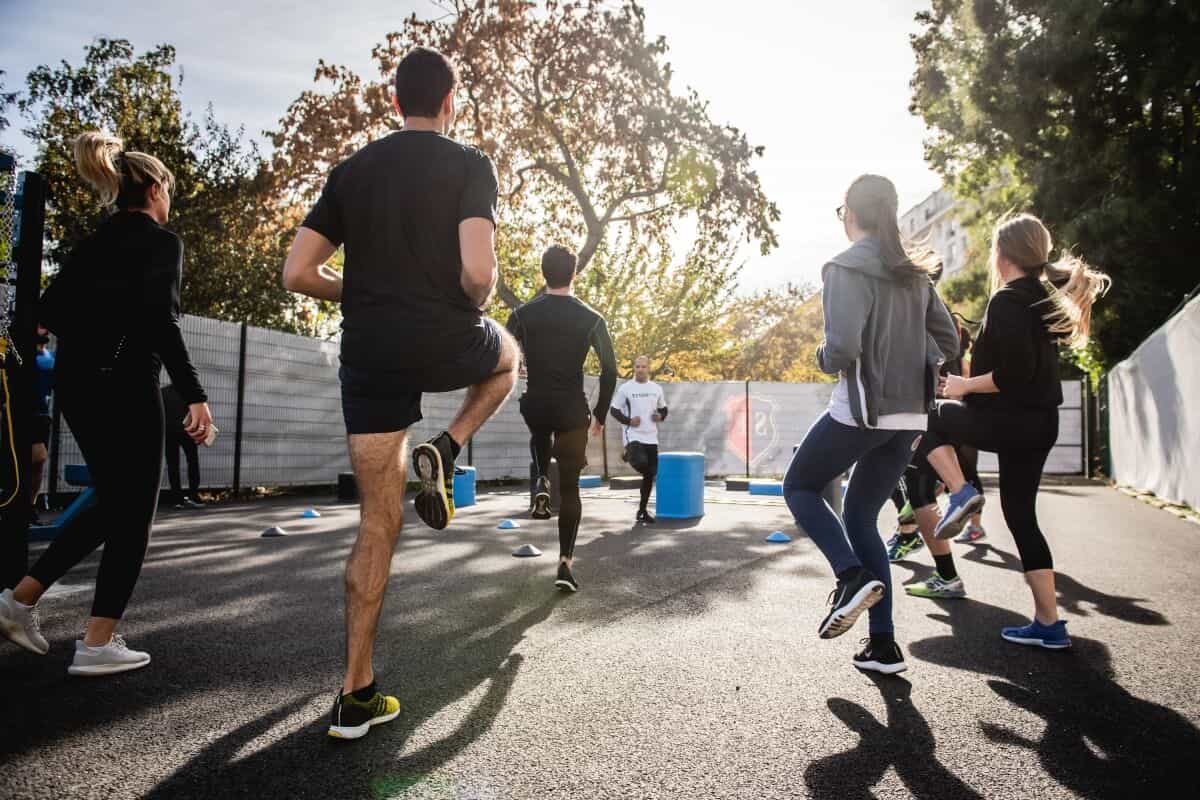- Did you have a cardiac event?
- Are you worried that your life is never going to be the same anymore?
You must be wondering…
- Will I be able to return to work?
- Will I ever become independent?
Well… These are totally normal concerns!
But you do not need to be worried, once your cardiologist ensures that your condition is stabilised, you can get your life back with a safe, customised cardiac rehabilitation exercise programme.
In this laser sharp Cardiac rehabilitation programme, your cardiac rehab personal trainer will walk you step-by-step from phase 2 to phase 4 cardiac rehab.
As soon as you get enrolled in a rehab programme, you should expect your personal trainer to:
- Address your problems
No matter what your problems are, if you are complaining of:
- pain
- breathlessness
- decreased effort
- swelling
- muscle weakness or
- poor balance.
A comprehensive assessment will help your elite personal trainer London based to address them at the roots, he would also check your medical reports, cardiologist recommendations and previous investigations to learn more about your case.
- Set your goals
Your cardiac rehab personal trainer will use the results of his comprehensive assessment to set clear short-term goals (e.g., improving your muscle strength or decreasing your pain but there is a lot more) and long-term goals (e.g., restoring your function and getting back to active, independent life etc).
- Design a laser sharp customised programme
A laser-sharp, goal-oriented and customised plan will be your shortest –– and safest –– way to meet your fitness expectations and helps you move beyond safely.
Based on your cardiologist’s recommendations, your cardiac rehab personal trainer will select only the effective and safe exercises to help you reach your goals.
If your cardiologist recommended exercising after a cardiac event but you think it worsens your symptoms, you may be doing the wrong exercises and you need to replace them with safer ones under professional supervision.
This programme is cardiologist supervised.
Consult Jazz Alessi about your case now in a free consultation!
Cardiac Rehabilitation Programme: Which Exercises Are Safe for Me?
Having a cardiac problem places some restrictions on the type of exercises you can do…
In general, your elite personal trainer will determine the best type of exercises based on your:
- Current health condition
- Cardiologist’s report and recommendations
- Previous and current fitness levels
- Functional problems (e.g., cannot do daily tasks)
- Physical problems (e.g., weakness, pain)
- Goals and ambitions
Based on these factors and more, your elite personal trainer London based will implement at least one of the following exercise categories in your cardiac rehabilitation exercise programme:

1. Aerobic Training
Research shows that your heart is a muscle that can be strengthened and reconditioned using safe aerobic training. [1]
A collection of 128 researches reported that aerobic training after cardiac events has the following benefits:
- Improves your heart’s ability to utilise oxygen
- Helps your heart to work less during different activities
- Improves your fitness
- Improves blood supply to your heart and skeletal muscles
- Lowers systolic blood pressure
- Helps the heart beat stronger and more efficiently
- Improves breathlessness and fatigue
- Reduces cholesterol and LDLs and
- prevents recurrence of heart attacks [1] [2], [9]
To make sure you are safe, your personal trainer does not need an ECG monitor, he will monitor your exercise intensity to keep it Low-to-moderate using different methods like resting and maximum heart rates. [3]
He will also schedule you for 3 times/week to gain the safest benefits of exercise following cardiac events before progressing to advancing the duration and intensity following evidence-based progression guidelines. [2], [3]
2. Strengthening Exercises
A customised resistance (strength) training programme 2 to 3 times/week, on nonconsecutive days and including a combination of arms, legs and core exercises is a very effective way to improve:
- Muscle strength
- Function and independence
- Cardiac muscle function
- Quality of life [2],[4]
While it plays a major role in reducing:
- Body and blood fat
- Insulin resistance
- Fatigue symptoms
- Risk of recurrence [2],[9]
In addition, a recent study has reported that a combined programme of strength and aerobic training revealed more long-term improvement in quality of life in comparison with aerobic exercise alone in women with coronary artery disease. [4]
Get stronger in a safe way by learning the best customised strengthening exercises for you.
Speak to Jazz Alessi who will listen carefully to your problems in details before prescribing an exercise plan.
Request a FREE CONSULTATION NOW!
3. Stretching and Flexibility
When it comes to cardiac rehabilitation programme, everyone knows how important pulse-raising activities are for heart health.
But, have you ever heard about the importance of stretching in cardiac rehab?
Stretching your muscles before and after your workout is necessary to:

- Warm-up your body and get it ready for exercise
- Prevent sudden increase in your heart rate
- Prevents sudden changes in blood pressure
- Prevent arrhythmia that is common in coronary artery disease
- Prevent injury to your muscles, ligaments and joints
- Prevent delayed onset muscle soreness [5], [6], [7]
Dietary Tips after a Cardiac Event
Although a comprehensive cardiac rehabilitation home exercise programme is required, exercising must be complemented by a proper heart-friendly diet to boost the effect of exercise and prevent recurrence.
Here are some professional tips:
Avoid saturated and trans fats
These poor fats (i.e., in fried and processed food as well as hydrogenated oils) increase your blood level cholesterol, triglycerides and LDLs which increases your risk for coronary disease and heart attacks. [12]
Calculate your calories
Creating a caloric deficit will help your body burn visceral fat and will improve your blood lipid profile.
Thus, it will prevent recurrence. [12]
Add Heart-healthy fats
Unsaturated fats like omega-3 and omega-6 will help you reduce your LDLs (bad fats) and increase your blood HDLs (good fats).
Therefore, research shows that it decreases your risk of heart attack. [12]
These good fats are found in vegetable oils (e.g., coconut and olive oils), nuts and avocado.
The Way Forward: Your Way Back to Normal Life
Like every other training programme, a cardiac rehabilitation programme progresses from easier to harder.
In rehabilitation, this is called the overload principle; and it plays an essential role in improving your:
- fitness,
- capacity and
- strength. [8]
The different thing in a cardiac rehabilitation programme is that your progression must be closely monitored to ensure you are exercising within your customised safe intensity. [8]
This is why your rehab programme is divided into 4 phases. [10],[11]
Usually, phase 1 starts early in the hospital, if you are hospitalised.
Phase 1 Cardiac Rehabilitation
For the rest of the phases, your personal trainer will work closely with your cardiologist and physiotherapist to monitor the progress and safety of your programme using objective and evidence-based methods. [11]
Your cardiologist will use ECG, Echocardiography and blood tests before referring you to a physiotherapist or a personal trainer. [1]
Phase 2 Cardiac Rehabilitation
If you are referred for physiotherapy in phase 2, you will exercise in a cardiac rehab unit and you will be monitored with ECG, continuous blood pressure measurement, RPE scales, METs and measuring VO2 max. [11]
Phase 3 and 4 Cardiac Rehabilitation
However, in phases 3 and phase 4 cardiac rehab, you will be discharged from the cardiac rehab unit and will be instructed to exercise with an expert elite personal trainer.
Your personal trainer will also ensure safety and monitor your intensity by calculating your maximum and target heart-rates [3] and monitoring your pulse and oxygen saturation using a pulse oximeter as you exercise.
- What to do after completion of the program?
You might be wondering…
- What happens after I reach phase 4 cardiac rehab?
In this last phase, your expert personal trainer will work with you step-by-step to integrate the whole cardiac rehabilitation programme into your lifestyle and turn it into an effective and safe cardiac rehabilitation home exercise programme.

During this phase he will teach you:
- How to monitor your symptoms and exercise intensity
- How to exercise safely at home with a customised cardiac rehabilitation home exercise programme
- The importance of regular exercise in preventing recurrence of cardiac events
- The heart-friendly foods you need to include in your diet
- How to quit habits that are harmful for your heart health.
So…
Before cardiac rehab, you have wished to get back to normal life.
But when phase 4 cardiac rehab becomes your lifestyle, you will realise that you have achieved a better-than-normal life with minimal or no restrictions at all.
And your life is just as it was before or very close to that point before you had your cardiac related event.
Conclusion
Going through a cardiac event like a heart attack or an open-heart surgery can leave you with too much anxiety, concerns and sometimes depression.
You may be concerned that your life will never be the same anymore….
You may think that your abilities have become limited…
And you may isolate yourself with the fear of recurrence.
However, a cardiac event is just another tough time you go through in life, after which your customised cardiac rehabilitation programme will help you go back to your normal life and will even help you prevent recurrence of cardiac problems.
With close team-work supervision and close monitoring, Jazz Alessi will create a laser sharp exercise and nutritional plan that will fit your case just like a glove.
Jazz will safely take you to the next steps along your rehabilitation course until you are ready and confident to work out on your own.
Feel free to talk to contact directly Jazz Alessi, the best London Personal Trainer for cardiac rehabilitation; request a free consultation now!
Who is Jazz Alessi?
- Jazz Alessi is an expert personal trainer based in London who works closely with cardiologists, MD and other medical professionals to safely change your life after a heart attack or a major cardiac event.Under cardiologist supervision Jazz will design a 100% safe and very effective comprehensive, laser sharp customised cardiac rehabilitation exercise programme. With his experience in working with cardiologists, MDs, training VIP, long term expert in injury rehab and elite clients.

Jazz will help you go back to normal life by addressing your physical problems and setting an evidence-based, laser-sharp personalised exercise and nutrition plan.
This will help you restore your body health; change the way you think and integrate a new healthy lifestyle to help you prevent future cardiac events.
REFERENCES
1. Mitchell BL, Lock MJ, Davison K, et al: What is the effect of aerobic exercise intensity on cardiorespiratory fitness in those undergoing cardiac rehabilitation? A systematic review with meta-analysis British Journal of Sports Medicine 2019;53:1341-1351.
https://bjsm.bmj.com/content/53/21/1341
2. Lavie, C. J., Thomas, R. J., Squires, R. W., Allison, T. G., & Milani, R. V. (2009). Exercise training and cardiac rehabilitation in primary and secondary prevention of coronary heart disease. Mayo Clinic proceedings, 84(4), 373–383. https://doi.org/10.1016/S0025-6196(11)60548-X
https://www.ncbi.nlm.nih.gov/pmc/articles/PMC2665984/
3. Mytinger, Megan & Nelson, Rachael & Zuhl, Micah. (2020). Exercise Prescription Guidelines for Cardiovascular Disease Patients in the Absence of a Baseline Stress Test. Journal of Cardiovascular Development and Disease. 7. 15. 10.3390/jcdd7020015.
https://www.researchgate.net/publication/340969106_Exercise_Prescription_Guidelines_for_Cardiovascular_Disease_Patients_in_the_Absence_of_a_Baseline_Stress_Test
4. Arthur HM, Gunn E, Thorpe KE, Ginis KM, Mataseje L, McCartney N, McKelvie RS. Effect of aerobic vs combined aerobic-strength training on 1-year, post-cardiac rehabilitation outcomes in women after a cardiac event. J Rehabil Med. 2007 Nov;39(9):730-5. doi: 10.2340/16501977-0122. PMID: 17999012.
https://pubmed.ncbi.nlm.nih.gov/17999012/
5. Mohammadi, Mohammad & Siavoshy, Hojjatollah & Abadi, Maryam & Maleki, Mohammad. (2020). A review of cardiac rehabilitation and exercise in cardiovascular disease Azadeh Naderi Master of Sport Physiology, Iran. 2020. 10.31838/jcr.07.01.32.
https://www.researchgate.net/publication/339042260_A_review_of_cardiac_rehabilitation_and_exercise_in_cardiovascular_disease_Azadeh_Naderi_Master_of_Sport_Physiology_Iran
6. Behm, David & Blazevich, Anthony & Kay, Anthony & McHugh, Malachy. (2015). The Importance of Stretching. 10.13140/RG.2.1.2807.6888.
https://www.researchgate.net/publication/286264646_The_Importance_of_Stretching
7. Oxford radcliffe hospital NHS trust: Cardiac Rehabilitation Exercise Programme (Blackbird Leys)
https://www.ouh.nhs.uk/patient-guide/leaflets/files/091011cardiacrehableys.pdf
8. Khushhal, Alaa & Nichols, Simon & Carroll, Sean & Abt, Grant & Ingle, Lee. (2020). Characterising the application of the “progressive overload” principle of exercise training within cardiac rehabilitation: A United Kingdom-based community programme. PLOS ONE. 15. e0237197. 10.1371/journal.pone.0237197.
https://www.researchgate.net/publication/343646657_Characterising_the_application_of_the_progressive_overload_principle_of_exercise_training_within_cardiac_rehabilitation_A_United_Kingdom-based_community_programme
9. Moreira, Mônica & Souza, Helder & Schwingel, Paulo & Sa, Cloud & Zoppi, Cláudio. (2008). Effects of aerobic and anaerobic exercise on cardiac risk variables in overweight adults. Arquivos brasileiros de cardiologia. 91. 200-6, 219.
https://www.researchgate.net/publication/23473516_Effects_of_aerobic_and_anaerobic_exercise_on_cardiac_risk_variables_in_overweight_adults
10. Keteyian, Steven & Mellett, Peggy & Fedel, Frank & McGowan, Cathy & Stein, Paul. (1995). Electrocardiographic Monitoring During Cardiac Rehabilitation. Chest. 107. 1242-6. 10.1378/chest.107.5.1242.
https://www.researchgate.net/publication/15449505_Electrocardiographic_Monitoring_During_Cardiac_Rehabilitation
11. Bonnie Sanderson PHD 2011 – Exercise intensity in Cardiac Rehab, the clinical side of the coin, Auburn University
http://assets.escardio.org/assets/Presentations/EPR2011/Europrevent-0100-Sanderson.pdf
12. Stanford healthcare –– Good fats, Bad fats
https://stanfordhealthcare.org/content/dam/SHC/clinics/preventive-cardiology/docs/good-fats-bad-fats.pdf




